Sun conure is very popular among fanciers because of its bright and attractive colors. Sun conure parrot for sale in Pakistan on different price ranges in different parts of Pakistan. Sun conure hand tamed parrot price is relatively higher than parent feed parrot. Sun conure has the following price range
- Sun Conure Chicks price is around 18,000 PKR to 25,000 PKR
- Adult Sun Conure price is 35,000 PKR to 40,000 PKR.
- Sun Conure Breeder Pair price varies between 85,000 PKR to 95,000 PKR.
Sun Conure Parrot Price in Pakistan
Sun conure for sale in Pakistan is available. Although it is banned on the international market for sale purchase due to its population is in danger. Sun conure price may vary from its stages as discussed above.
Sun Conure Chick Price In Pakistan
Sun conure chick price in Pakistan is about 15000 PKR at the age of 1 to 2 months. Sun conure hand-feed chicks have a little high price as compared to parent feed sun conure chicks. People raise their hand feed for their business purpose. Sun conure chicks price in Islamabad is relatively high from Sun Conure Market in Karachi.
Sun Conure Young For Sale
Young’s price in Pakistan about 30 to 38 thousand Pakistani Rupee. Most people have hand-tamed Sun Conure young parrots.
Sun Conure Adult Price In Pakistan
Sun Conure Adult age is 2 years. Adult Sun conure is ready for breeding and as the market price may be high, adult sun conure price in Lahore 55000 PKR and may vary from city to city, price of adult sun conure in Karachi is bit low, vast market, many birds, much competition.
Sun Conure Breeder Pair Price In Pakistan
Sun conure breeder pair price is about 85 to 90 Thousand Pakistani Rupees. People have done DNA of Sun conure pairs. Confirm Breeder Pair of sun conure breed 3 times in professional sheds. Owners pick their eggs and place them under Green Ringneck for hatching and in this way, Owners pick another breed from Sun Conure.
Conure History And Types
Sun Conure Parrot is a small to medium size parrot, very diverse in its type. Combination of different but beautiful colors in each type of conure.
Common property in Conures is a long tail with a small beak with usually the color Grey or Black. Always keep the attention of the person, having dancing and moving ability front and backward. Here are some types of Conure:
Sun Conure Types
There are 10 different types of Conure:
- Sun Conure
- Jenday Conure
- Dusky Headed Conure
- Nanday Conure
- Maroon Bellied Conure
- Peach Fronted Conure
- Red Masked Conure
- Blue Crowned Conure
- Patagonian Conure
- Green Cheeked Conure
- Conure Parakeet
Interesting Facts About Sun Conure Parrot
Sun Conure is one of the best parrots in intelligent, very bright colors, much affectionate, and can learn tricks and tips with some effort. People are very much interested in this parrot because it is a medium-cost parrot, available at easily affordable prices. Very aggressively react if you ignore it. Sun conure price is affordable, size is medium, easily handled.
Now we discuss more interesting facts about the Sun Conure.
Breeding Age of Sun Conure
Conures tend to reach sexual maturity at an average age of about one to two years old; those that are “early bloomers” may breed sooner, while those that mature more slowly might not start until about 1.5 to 3 years of age. Once these “birdies” have reached the age of about nine or ten years old, they generally lose the ability to reproduce.
Sun Conure Lovely Bird
The Sun conure is also called Sun Parakeet. It’s a very colorful and attractive parrot. Its a medium size parrot. Very intelligent parrot, Sun conure can memorize hundreds of words. People teach their parrots tips and tricks and this parrot learns tricks like climbing stairs, sitting on sticks very fastly.
Origin
Sun conures exist in North America, the coastal area of Guayana, Venezuela, and Brazil. In wild, they are inhabitants of Savanna dry woodlands. Sun Conures make their nesting in dry woodlands, fruity trees, and coastal area forests.
Description
Sun Conure is a very famous parrot because of its great companionship, expressive quality, intelligence, vibrantly colorful, and medium-size. It can be recognized easily due to its attractive orange color, with some greenish color along with its feathers and some yellow mix.
Sun Conure is almost 110 g in weight and 12 inches long with its big mouth and strong solid dark black beak. It has circled around the eye with a long colorful tail.
Sun Conure Diet
In the Wild, Sun conures eat fresh fruits, seeds, flowers, blossoms, nuts, insects, and ground vegetables. They feed both ripe and half-ripe fruits and berries. They need more protein intake during the breeding season, more calcium during grooming age while young, and need more carbohydrates when laying eggs
While in captivity, especially manufactured pellets to fulfill their Calcium, Vitamin D deficiency, fruits ( apple, banana, strawberry, grapefruits) and in vegetables ( carrot, peas, sweet potato, spinach).
Change chlorinated water daily. Try to avoid fruits seeds, alcohol, avocado, hard nuts, these can create medical problems for your Sun conure.
Male-Female Differentiation
Sun conures look the same at the age of plumage. No one can not differentiate between males and females at the age of plumage. Only if, the DNA test is recommended for getting to know males and females in Sun Conure.
At age of 2 years minimum, Sun conure becomes an adult. In adults, one can recognize a male sun conure and a female sun conure. Male sun conure has a shocking yellow crown, lesser wing coverts, face and belly become orange with red around ears.
Wings from the inner side become dark greyish, the tail is green with a blue tip, the bill is black. The legs and eye-ring are grey but sometimes grey converts to white in captivity.
Breeding Age
Sun conure breed 1st time at age of 2 to 3 years approximately. It becomes an adult at the age of 2 years.
Sun Conure Breeding Season
The breeding season of Sun Conures in Pakistan starts from November and it remains up to May. During this period, Sun Conures breed 2 to 3 times.
Clutch Size
Sun conure single-clutch size consists of 3 to 4 eggs. When a couple of sun conures cross, female sun conures lay these eggs in 2 to 3 days.
Sun Conure Hatching Period
Sun conure incubation period or Hatching period is 24 to 27 days. During this period female sun conures keep sitting inside the nest and only 2 to 3 times come out from the nest for feeding. During the day, the male sun conure keeps sitting outside and takes care of the nest.
Sun Conure Behavior
Sun conure is a very friendly, affectionate, loving parrot. In the wild, they live in flocks of 15 to 30 individuals. They rarely leave the flock. If it happens then they produce sharp and vocal sounds which can be heard hundreds of meters and in response, others reply to the voice to communicate with each other.
They travel many miles daily in flocks, while flying they produce voices in high volume and when they are in breeding days, normally they are quiet.
In captivity, a must interaction is compulsory, otherwise, they bite you and be aggressive. It is a very smart and intelligent parrot, so it needs constant attention, love, care, and spending time with your parrot.
Sun Conure Sounds And Vocalization
Sun Conure sounds in the wild are very vocal and they travel in flocks. They never leave the flock or if sometimes it happens, then the sun conures a high bass sound which can be heard from hundreds of meters, and their fellows respond to its vocal sound.
In captivity, the sun conure sounds high. They are not shy parrots, if the sun conure dislikes something or feeling neglected then they express this by their high volume sounds. Sun conure is not a room keep a parrot. It needs to be open like space.
Sun Conure Talking Parrot
Sun conures as a talking parrot, not to be considered. They do not have the ability to mimic human speech or as Raw Parrot or Macaw Parrot or Grey Parrots or Eclectus Parrots mimic human words.
Sun conures mimic the buzzer sound, telephone ringing, or whistling sounds.
Cage Size
Sun conures cage size must be ( 2x2x3) feet ( length x width x height) in feet. There must be less distance in surrounding bars, so that sun conure may not its head stuck in between bars. This space of a cage for sun conure is good for a flair up its wings and can feel relaxed inside.
Sun conure is an athletic type parrot, it likes to stretch legs and open feathers so must provide a play gym on top of the cage to keep sun conure in a happy mode.
Sun Conure Diseases
Like other parrots or Conures, sun conure may also be affected by diseases and can suffer from different types of health issues. We will most probably discuss health issues that can affect sun conure.
Sign of Disease In Sun Conure
Some signs and symptoms may reflect that Sun Conure is suffering from the disease. Following may be signed:
- Fluffed, plucked feathers
- Discolored or running stools
- Sitting on the floor of the cage
- Weight loss
- Swallow eyes
- Discharge from eyes or beak
- Coughing
- Beak swallowing
Different Health Issues
- Feather Pricking
- Fever
- PBFD
- Diarrhea
- Fungal Infection
- Bacterial Infection
Feather Pricking
Feather pricking or Feather Plucking is due to some medical reasoning but more often this happens when Sun Conure gets bored or lacks attention or when you ignore your parrot. Then the parrot started plucking its feathers and trying to hurt it.
So if feather plucking is due to some medical reason then consult your veterinarian immediately and start the treatment or if this is due to lack of attention, then give proper time to your sun conure. Install toys, chewing things, artificial stairs, stick inside the cage, so the Sun conure does not feel bored and enjoy most of the time.
Fever
When sun conure suffers from fever then its body temperature rises high, less appetite, lazy stuff, avoids flying and keeps sitting on the floor of the cage. Consult your veterinarian and on his suggestion, use the medicine to overcome fever.
Another reason for fever is when your parrot travels from one place to another place then it gets tired. So because of this, sun conure may suffer from fever. Use 3 to 4 drops of Brufen syrup in water and 2 to 3 times a day. Your parrot may get better and start to interact with you and fly also.
PBFD( Psittacine Beak and Feather Disease)
PBFD stands for Psittacine Beak Feather Disease, in this disease, Beak gets damaged, feathers all gone, the whole body is squeezed, and in severe condition, sun conure may die. Consult a veterinarian for some medical treatment. No vaccination of this disease exists right now. So keep your infected parrot separate from your aviary.
Loose Motions
Diarrhea is another disease in which sun conure may suffer. Loose motion or discolored pits can be seen in this disease. Sun conure becomes weak, unable to take free fly, lethargic and lazy feelings due to loose motions.
Must consult a veterinarian, ask for a solution, if he suggests some vaccination then, inject vaccination to your parrots. On a local level, at home Flagyl syrup drops are helpful in this disease. Try to avoid the heat, keep your parrot cage and environment cool. Control humidity and heat within the shed where their aviary was installed.
Fungal Infection
Sun conures are most commonly infected by 5 types of fungal infections:
- Candidiasis
- Rhodotorula
- Cryptococcosis
- Aspergillosis
- mucormycosis
There are different types of reasoning for above mentioned fungal infection like:
- Poor Nutrition
- Poor Ventilation
- Respiratory Toxins
- Poor Immune System
- Overcrowding Within Cage
The most common symptoms are laziness, lethargy, weight loss, loss of voice, diarrhea, or breathing problem. In Rhodotorula infection, the yellowish crust develops over the skin.
The treatment of fungal infections may take amphotericin B, clotrimazole, or itraconazole.
Bacterial Infection
Bacterial infection is very common in pet birds. Different types of bacterial infectious diseases can infect your birds. Bacterial infections’ incubation period can longer than 3 days to several weeks. Here some bacterial infections are listed:
- Chlamydiosis
- Avian MycoBacteriosis
In Chlamydiosis bacterium, all companion parrots and birds can be infected. It is an intracellular bacterium. The incubation period can be 3 days to many days. Clinical symptoms are irritation discharge, depression, diaherra. This bacterial infection may affect cockatiel, budgerigar, sun conure, and all types of other parrots. Doxycycline is the treatment for Chlamydiosis bacteria for up to 45 days. Calcium resources may be reduced when Doxycycline treatment is ongoing orally.
In Avian MycoBacteriosis, birds of Amazon, parakeets, sun conure are mostly infected. Clinical signs are anorexia, weight loss, and diarrhea. It is hard to diagnose this bacterial infection. Specialist veterinarians suggest a liver biopsy, PCR test. In this infection, the Liver of your parrot is infected and this bacteria also develop strength against So it takes up to 12 months for treatment of this bacterial infection.
Sun Conure Chicks
Sun conure chicks are very valuable. When breeder pair lay down eggs then you have 3 options to hatch Sun conure chicks from eggs:
- Let Breeder Pair To Hatch Eggs
- Put Their Eggs In Incubator
- Put Their Eggs under Green Ringneck Pair
Types of Hatching Sun Conure Eggs
1- Incubator
Hatching eggs in incubators is rare. Because incubators are used when your sun conures are not able to hatch their eggs properly and in the middle of hatching after 2 to 3 weeks, they destroy their eggs. The incubator for hatching eggs artificially is the best option. Set the temperature of the incubator and place eggs in it.
2- Sun Conure Self Hatching Eggs
It is good to hatch eggs sun conure itself. Female sun conures keep the eggs warm, sit for maximum time and during this period, male sun conures stay outside the nest for security purposes to keep from external issues.
3- Put Sun Conure Eggs Under Green Ringneck Pair
Sometimes people put sun conure eggs under Green Ringneck Pair and couples hatch the eggs. People do this practice when they need extra breeding from Sun Conure Pair, by doing this, Sun conure breeds almost 3 times in a season.
Hand Raised Sun Conure Chicks
Hand-raised Sun conure chicks are a very hard process. One should take extra care of chicks as chicks have been taken out of their nest. Your one mistake can be the loss of your chick as a result. Chicks should be taken out from the nest at age of 3 to 4 weeks.
When chicks are taken out from their nests, they need warmth, feed, and care. So for warmth, a brooder is needed as extra equipment. Care and affection with them, sun conure chicks feel like co-human, then they have fun with you, joyful activities with humans, play with a hand, preen with hair and feel comfortable with humans.
Hand rearing a Sun Conure baby is a very complex task, needing skill to bring up the baby, feeding and care also. Hand feeding sun conures the baby by using a syringe and feeds very slowly so that the feed may reach the baby stomach easily. Also keep an eye on baby activities, if it shows lazy or less responsive then immediately consult the veterinarian. So older the sun conure baby when take out from nest more it will be strong and solid immune system and less time you have to feed your chick
Brooder
When Sun conure chicks have been taken out from nests for hand feeding and hand raising, then you need a brooder to provide them warmth and maintain the heat temperature. Sun conure babies need brooder until their plumage and feathers grow up.
Leg Bands For Sun Conure Chicks
Some owners use leg bands for Sun Conure Chicks as a sign and memorize their age and keep records easily. These leg bands are almost 6.5mm diameter and should wear in the legs of sun conure babies almost at age of 2 to 3 weeks because in growing age, their legs and bones are soft and leg rings can slip to their legs easily.
Sun Conure Raised Chicks
After hatching their chicks, the sun conure couple raises them very quickly. They start to feed and take good care of themselves. They feed them up to the age of 8 months up till then their feather and fully weaned.
Although parent raised chicks are not as friendly as hand raised chicks but Sun conure raised chicks have a strong immune system.
It is good to let them raise their chicks and not interfere in their raising chicks. Parents raised sun conure chicks are very good breed stock for upcoming days with less effort of growing.
Co-Parented Sun Conure Chicks Raised
Another method to raise Sun Conure babies is to let their parents raise chicks and you take them out for taming or training.
This will happen only in scenarios where the Sun conure couple has trust in you and they will not react when you take out chicks from the cage.
Because sometimes, male sun conure may kill or attack chick in this frustration and sometimes attack female sun conure.
If one person manages to share this space with Sun conures for raising their chicks, then it will be very helpful financially and as well as health-wise, chicks may have good immune systems, they receive brood and warmth from their parents.
Growth Stages of Sun Conure Baby
Sun Conure Chick can be mature and adult at age of 2 years so from Birth to Adult Age, Sun conure baby growth can be divided into 4 stages:
- Stage -1 (Birth to 6 Months)
- Stage – 2 (7 – 8 Months)
- Stage – 3 (8 – 12 Months)
- Stage – 4 (1 Year to 2 Years)
Stage – 1 ( Birth to 6 Months)
From Birth to 6 months, its initial stage, when Sun conure baby is just like a piece of flash, slowing and steadily growth starts, from week 3rd to 4th, feathers start to grow and up to 6 months, the whole body becomes green and yellowish.
Stage – 2 ( 7 to 8 Months)
At the age of 7 to 8 months, all feathers shed and new plumage starts to cover the body of Sun Conure Chicks. Feathers shed down equally from both sides of Parrot.
Stage – 3 ( 8 Months to 12 Months)
Up to the age of 1 Year, hair around the neck starts to grow, yellowish around neck and orange feathers colors.
Stage – 4 ( 1 Year to 2 Years)
From young to Adult age, sun conure chick when reaching 2 years age, it’s fully matured and ready for making a couple and breed. Nail, Tail, Fly, All in the best form.
Sun Conure Baby Behavior
Sun conure parents feed baby behavior is different from Hand fed sun conure baby. Parents who feed sun conure babies may fear humans, as their parents. They react to aggressive behavior when humans interact with them or come near to them.
On the other hand, hand-reared sun conure babies enjoy human company, no fear with them, cuddle with them. Hand-fed sun conure babies may adopt humans easily and need more care and attention.
FAQs
What is the cost for Sun Conure Parrot?
Sun Conure bird cost varies from country to country. The major factor associated is the type, color, age, and intelligence level of the Bird. Nowadays it’s the cost is from 500 USD to 1500 USD.
Does Sun Conure Talk Like Humans?
It is worth noticing that Sun Conure can’t talk like humans but these are intelligent birds. These parrots can learn quickly and do reproduce sounds. Like if you are whistling regularly it will respond to you with a whistle. Even dog barking, opening door sounds, or any other sound that reaches this bird, it learns it.
If you are looking for talking parrot then you have to look for African grey parrots.
What does Sun Conure Eat?
Sun conure in the wild eats seeds, fruits, vegetables, and nuts. While in captivity, a sun conure diet must be balanced with pellet, leafy green vegetables, fruits, nuts, some vitamin supplements, and chlorine-free water. Change the water on a daily basis.
When is Sun Conure Breeding Season in Pakistan?
Sun conure breeding age is 2 years. At this age, sun conures are ready for breeding. Sun conure breeding season starts from December and it remains up to April.
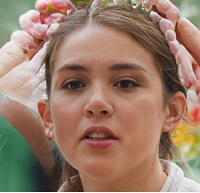
Bird Enthusiast
Masters in Counseling & Data Sciences
University of Maryland
Professional Parrots, Pigeons Breeder and Keeper
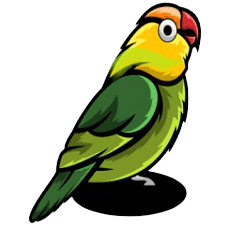
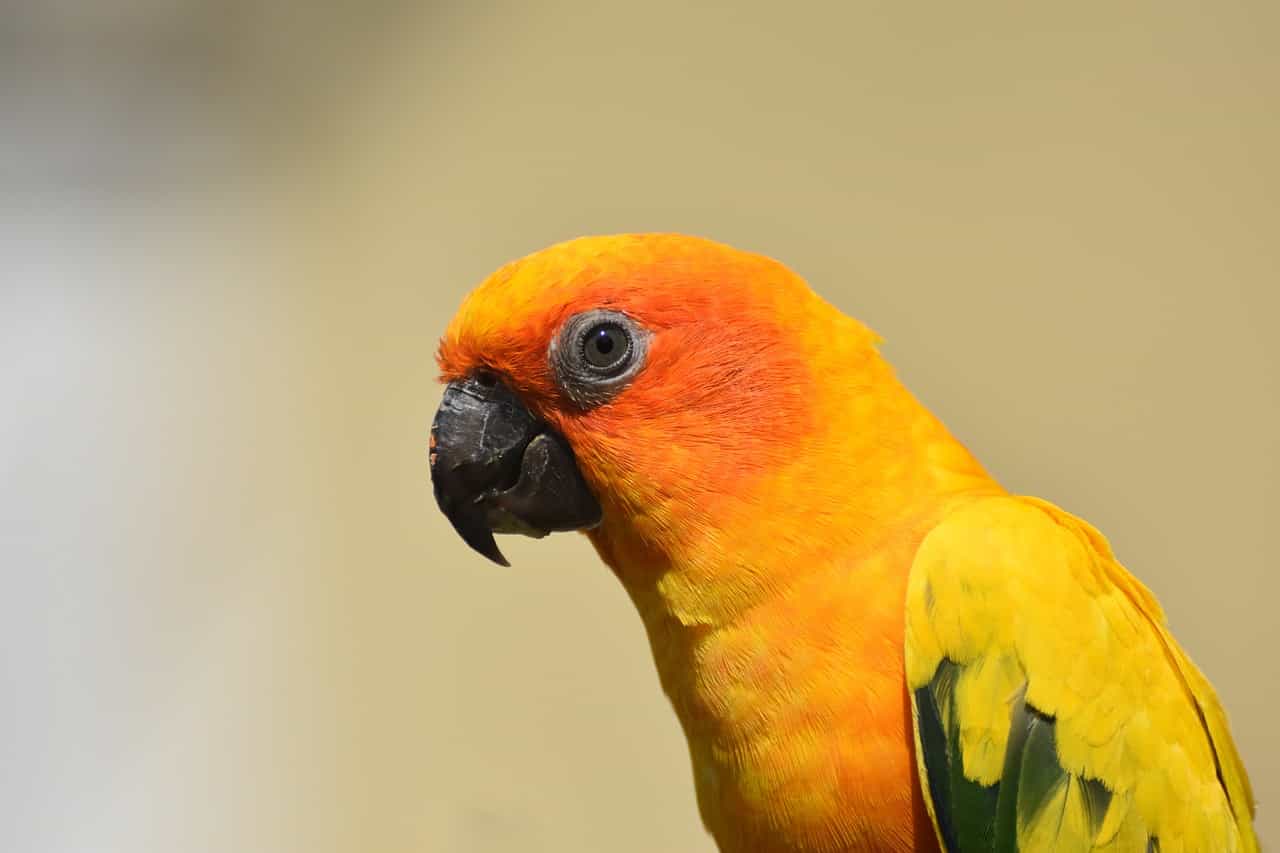
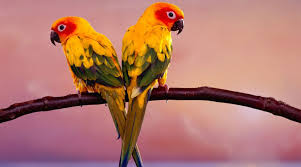

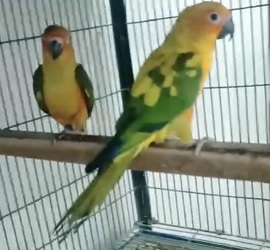
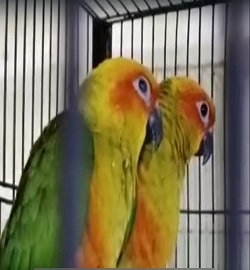
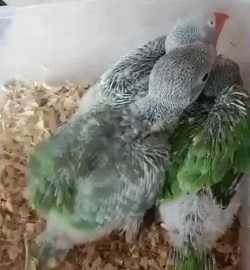
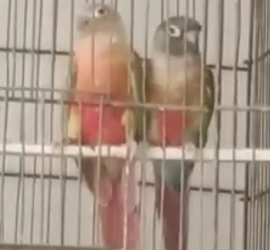
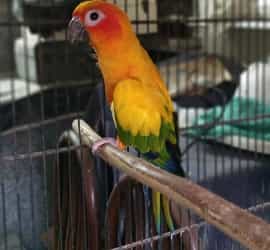
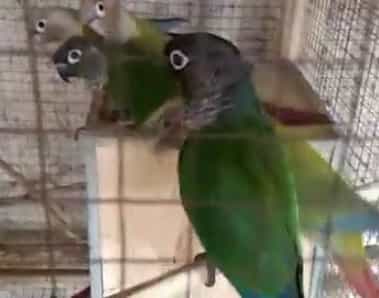
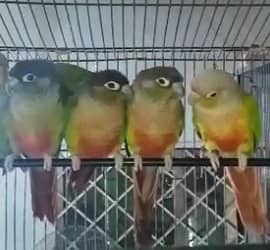
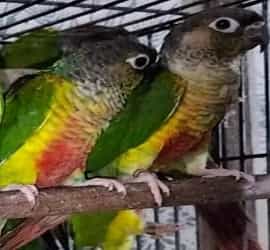
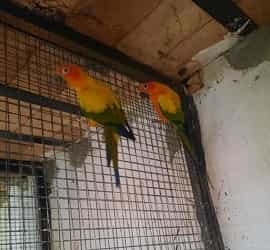
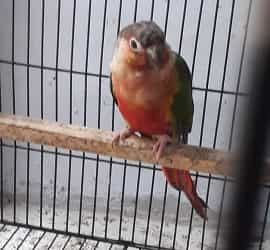

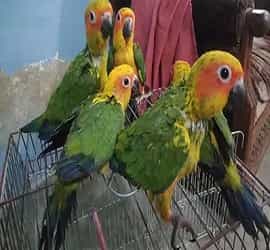
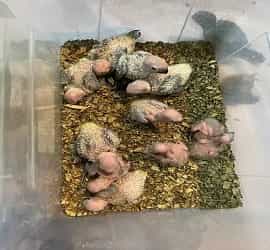
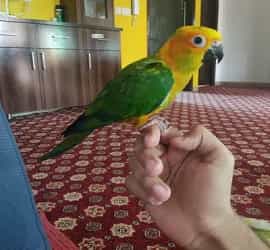
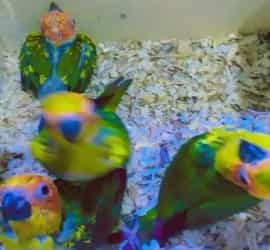
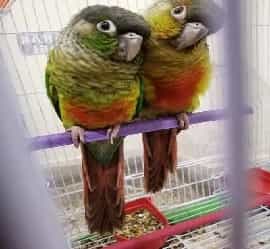
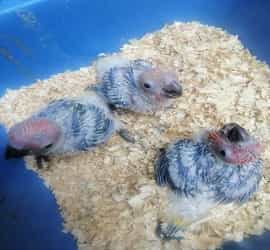
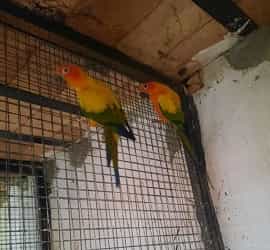
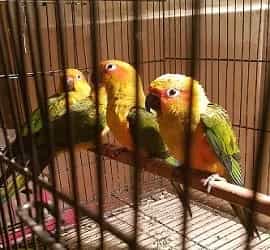
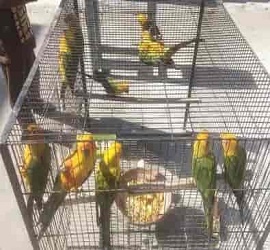
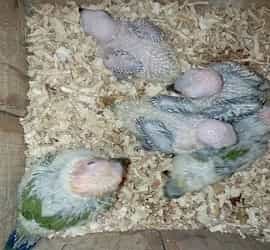
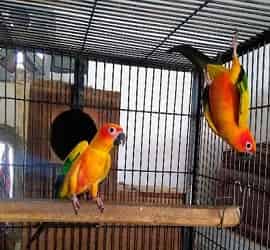
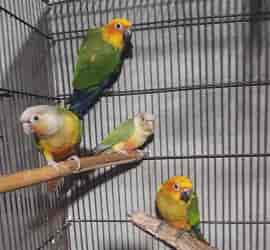
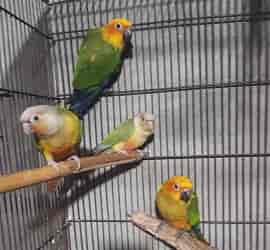
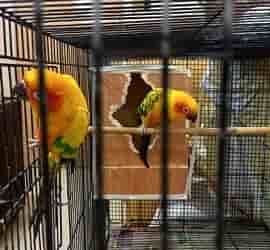
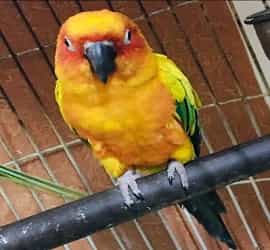
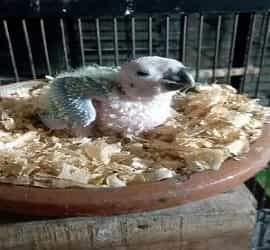
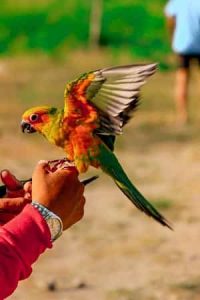
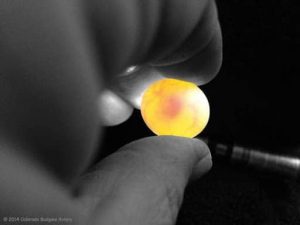

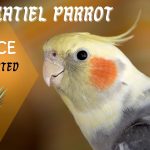

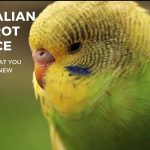

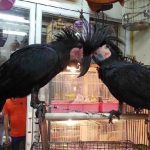

Sun Conure is a beautiful parrot. I was missing this information about the sun conure parrot price range. Nice information thanks for sharing.